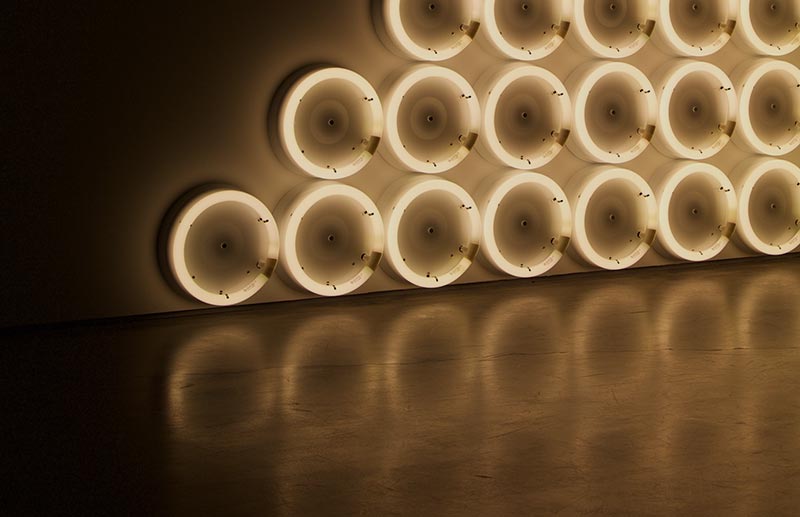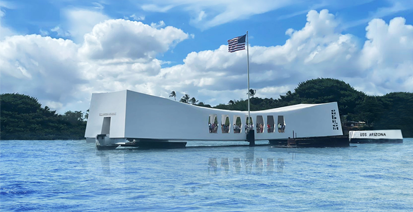Pearl Harbor’s Peace Symbol
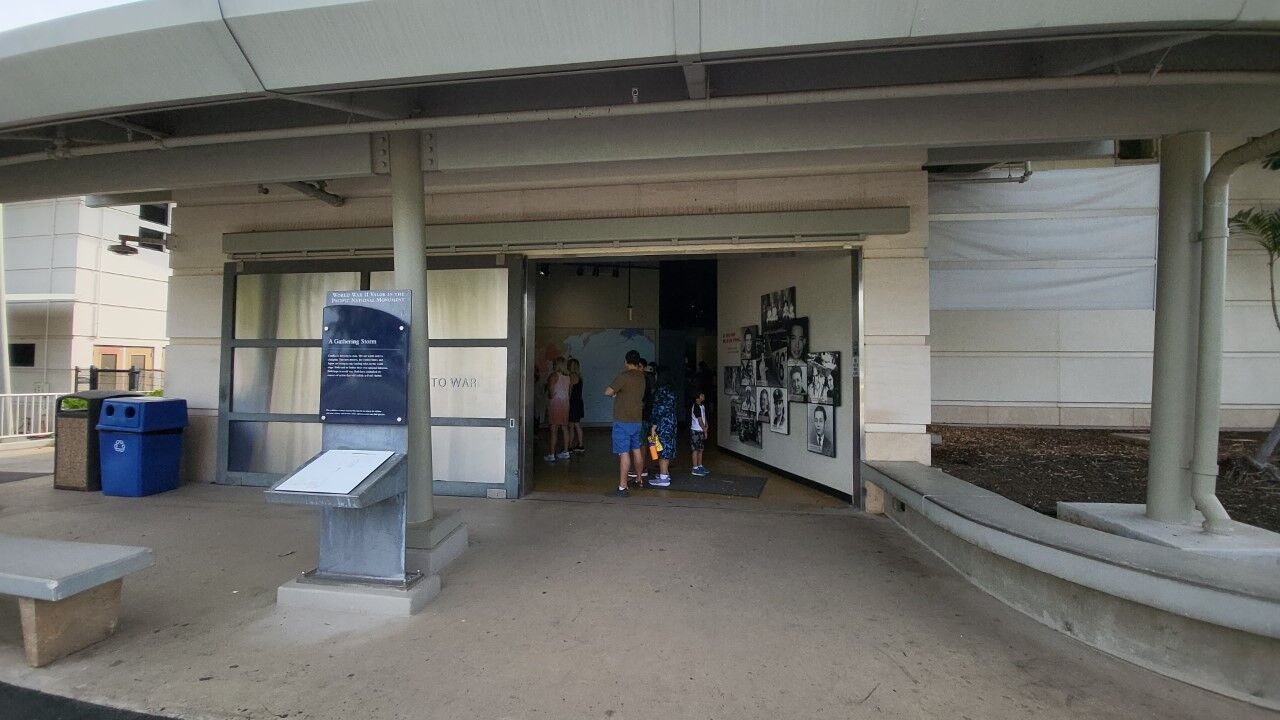
The entrance to the “Attack” Museum at the Pearl Harbor National Memorial. The museum covers the details of the Pearl Harbor attack as well as the aftermath.
Within the “Attack Museum,” behind its movie theater, is the Sadako Sasaki display. In war, it’s not only the soldiers who are the casualties. This display is visited by a thousand visitors each day, and her story is known in Japan, the United States, and many countries throughout the world; and is one of the most emotional stops while taking your USS Arizona Memorial Museum Tour.
Sadako was only two years old when the atomic bomb was dropped on Hiroshima on August 6, 1945. Most of her relatives, neighbors, and friends died that day, but at the time, Sadako seemed unhurt. Eight years later, she started not feeling well, constantly tired and dizzy. Her concerned relatives took her to the Red Cross Hospital, and she was diagnosed with leukemia, known to the locals as the fatal “A-Bomb Disease.”
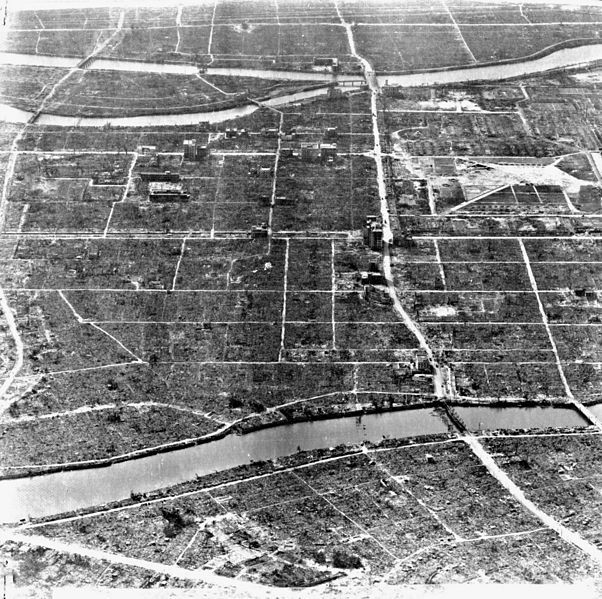
Aerial view of the destuction at Hiroshima, Japan, caused by the atomic bomb dropped on the city., U.S. Navy (The image is part of a scrapbook assembled by Commander Francis N. Gilreath during his service as Flag Secretary and Aide to Rear Admiral Alfred E. Montgomery), U.S. Navy National Museum of Naval Aviation photo No. 1987.096.001.112, PD-USGov

This is Sadako Sasaki in 1955, when she developed purpura and was taken to hospital., Unknown author, http://yutaka901.fc2web.com/kssrtnjsad21.jpg, PD-Japan-oldphoto, PD-Pre1978
Sadako, her family, and her schoolmates were all very concerned and scared. While in the hospital, Sadako heard from one of her friends about the legend that sick people could get well if they folded 1,000 cranes. After this, Sadako decided to fold 1,000 cranes to get her wish granted for good health.
Even though she was in great pain, she continued to fold her cranes, asking her nurses for tiny pieces of paper to complete her project. She was always in a cheerful and helpful mood during her last months and eventually folded the 1,003th crane before dying at the age of 12.
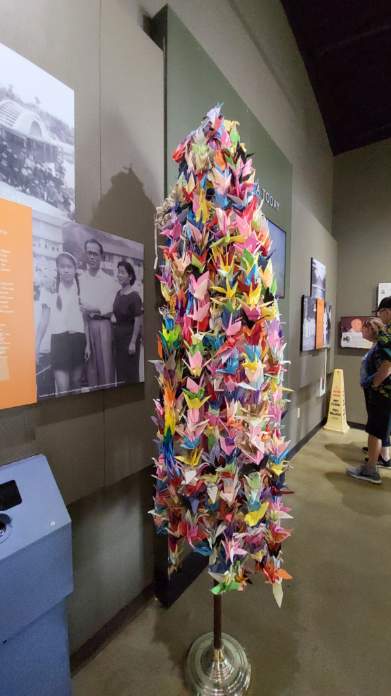
The Sadako Sasaki Peace Crane exhibit at the “Attack” museum at the Pearl Harbor Visitor Center. The Peace Crane exhibit was brought to Oahu in the hopes of inspiring World Peace.
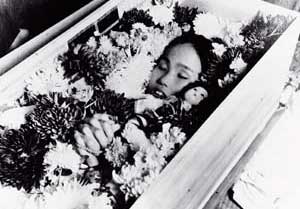
Sadako Sasaki in the coffin, Unknown author, http://www.pcf.city.hiroshima.jp/virtual/VirtualMuseum_j/exhibit/exh0107/exh01072.html, PD-Japan-oldphoto, PD-Pre1978
Sadako’s teachers and schoolmates were saddened by her death and decided to start a unity club to honor her. This club spread to 3,100 schools in 9 countries, and a fundraising project was created to build a monument in her honor and to the other children that lost their lives to the A-Bomb Disease. After her death, enough money was raised to develop her peace monument three years later. The memorial is called the children’s Peace Monument, within the Hiroshima Peace Park, very close to where the bomb was dropped.
On Sept 21, 2013, Sadako’s 70-year-old brother, Masahiro Sasaki, and the chairmen of the non-profit “Sadako Legacy” donated one of the three original cranes owned by the family’s nonprofit organization created by Sadako Sasaki. The crane is so tiny and perfect that it is housed in a special nitrogen-air $80,000 display (donated by the Honolulu Japanese Chamber of Commerce) that protects and magnifies the crane so that visitors can get a good look at its perfection.
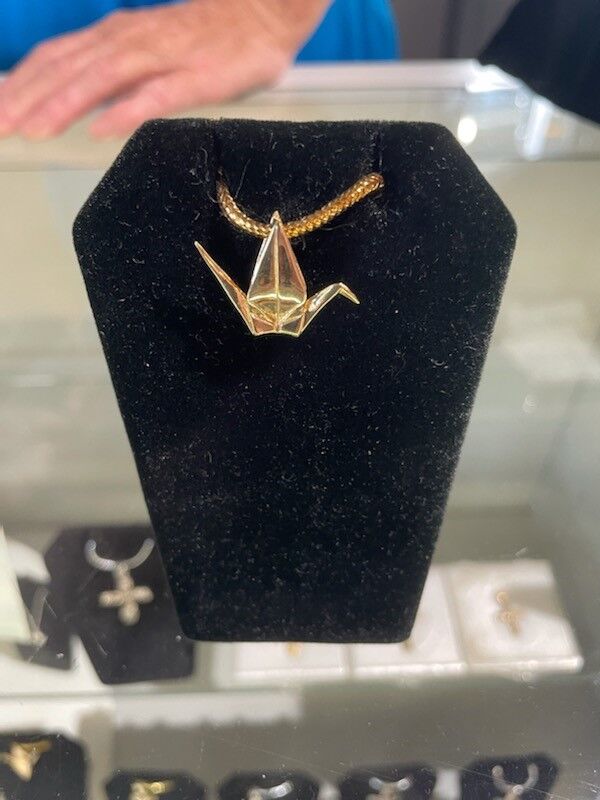
A crane pendant on display at the Pearl Harbor Museum Store. This item is part of the Peace Crane collection which is a jewelry collection commissioned by Pacific Historic Parks.
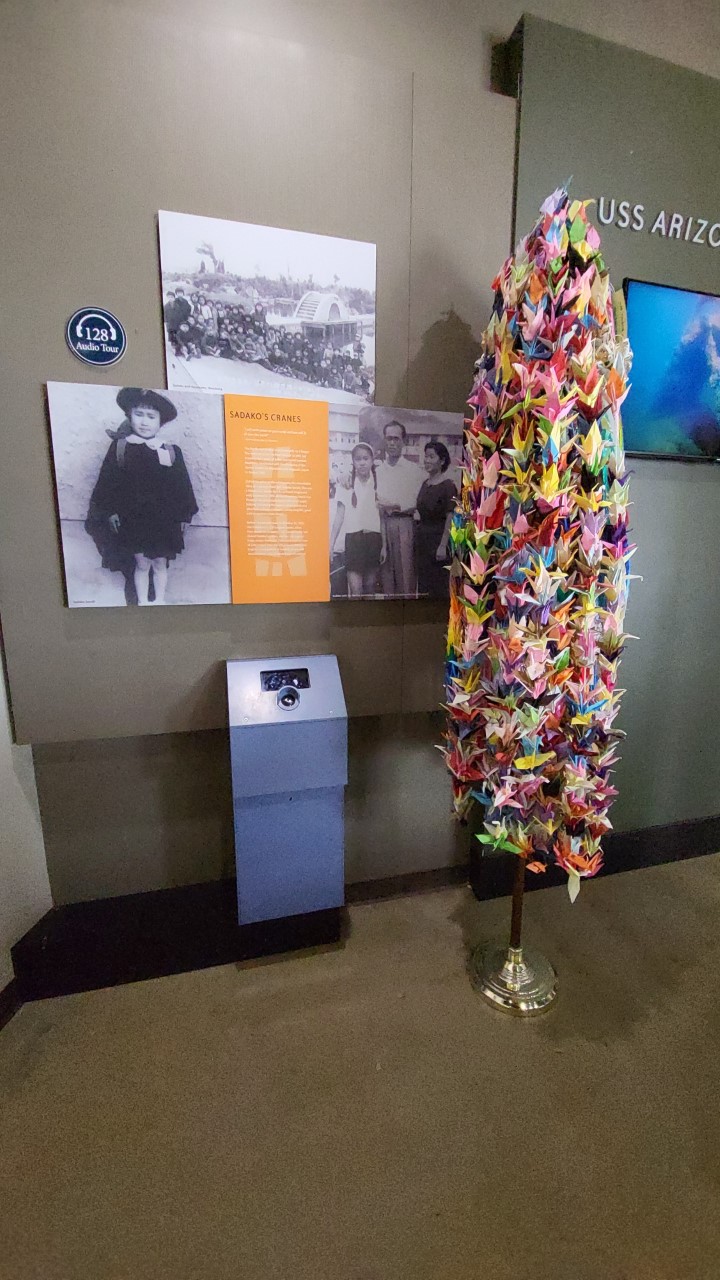
Sadako’s Cranes exhibit in the “Attack” museum at Pearl Harbor. The box in the center houses one of the cranes originally folded by Sadako before she died of Leukemia caused by radiation exposure.
During a speech at the Pearl Harbor Visitor Center, Masahiro explained why they chose the Pearl Harbor Visitor Center to be the home of one of the few remaining Sadako cranes, “We hope the country that started the war by attacking Pearl Harbor in (1941) and the other that ended the war by dropping the atomic bombs (in 1945) will reach an end of the war from the heart, discarding their old grudges. We hope the origami will catalyze that.”
Clifton Truman, the grandson of President Harry Truman, who authorized the dropping of the two atom bombs on Japan, worked as a go-between the Sadako family and the National Park Service to get the crane placed within the museums at Pearl Harbor Visitor Center.
At the crane-donating ceremony was a Japanese pilot that had participated in the bombing of Pearl Harbor and a Pearl Harbor Survivor, two old warriors who both went on stage and shook hands in a gesture of reconciliation, a very moving moment at this special Pearl Harbor Visitor Center event.

The Sadako Saki Exhibit in the “Attack” Museum in Pear Habor features 1000 cranes that were folded by volunteers. The cranes on display are periodically replaced.
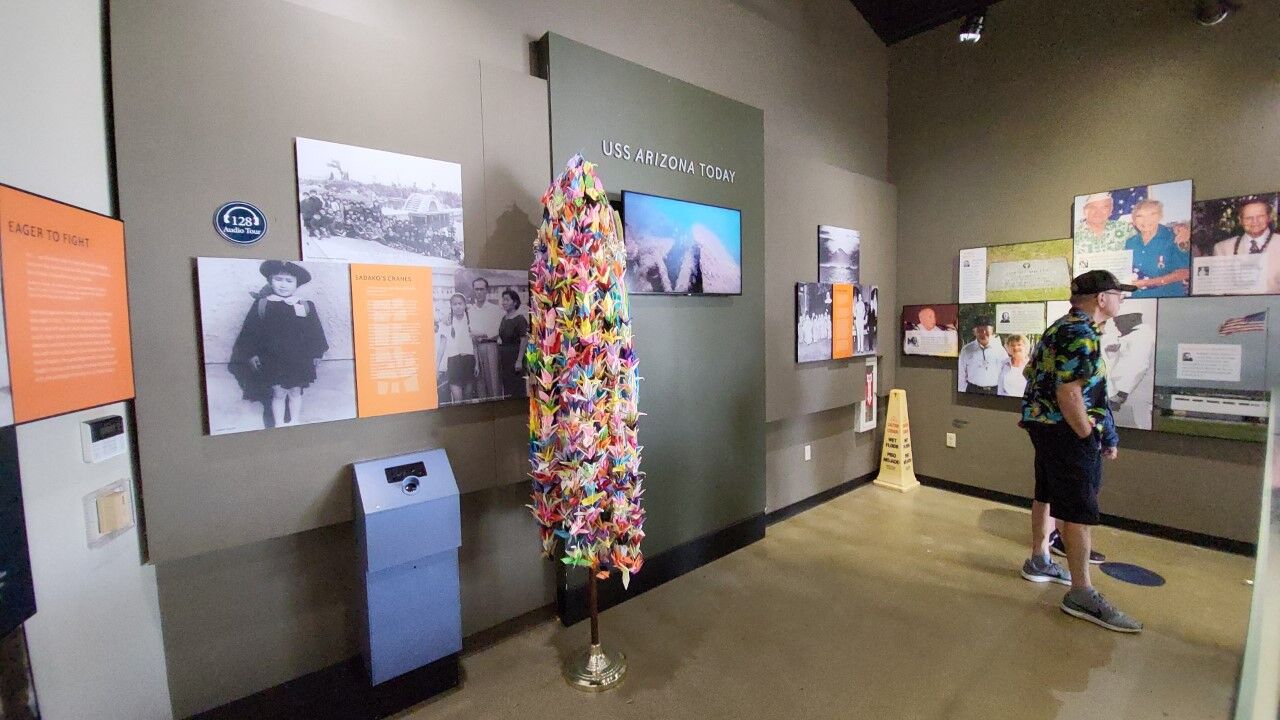
The Sadako Sasaki exhibit takes up a small corner of the “Attack” museum at the Pearl Harbor Visitor Center.
Every year over 10,000 Japanese students come to pay their respects at the USS Arizona Battleship Memorial and the Sadako Sasaki display. In Japan, WWII is not taught in any detail to students, so they are always shocked by what they learned while at Pearl Harbor. At the Sadako Sasaki display, many Japanese student groups drape a string of 1,000 paper cranes around her picture. After a couple of weeks, these cranes are given out at the USS Arizona Memorial Museum Store as gifts to make room for the next Japanese student’s cranes.
In 2017, the National Park Service approved the concept of the USS Arizona Memorial Museum Store, creating a “Sadako Sasaki Crane Collection” as an “International Symbol of Peace.” This exclusive merchandise is offered in paper, silver, and gold and is truly magnificent. Products include pendants, earrings, and bracelets, which can only be found at the Pearl Harbor Visitor Center. This crane jewelry collection comes with a Maui Diver’s 100% customer satisfaction guarantee and a lifetime warranty and is as beautiful and delicate as the Sadako crane on display.
Each piece of jewelry comes with a National Park Service interpretive card explaining Sadako Sasaki’s relationship to Pearl Harbor. Proceeds from the sale of the Sadako Sasaki crane merchandise support the restoration, preservation, and educational programs at the Pearl Harbor Visitor Center.
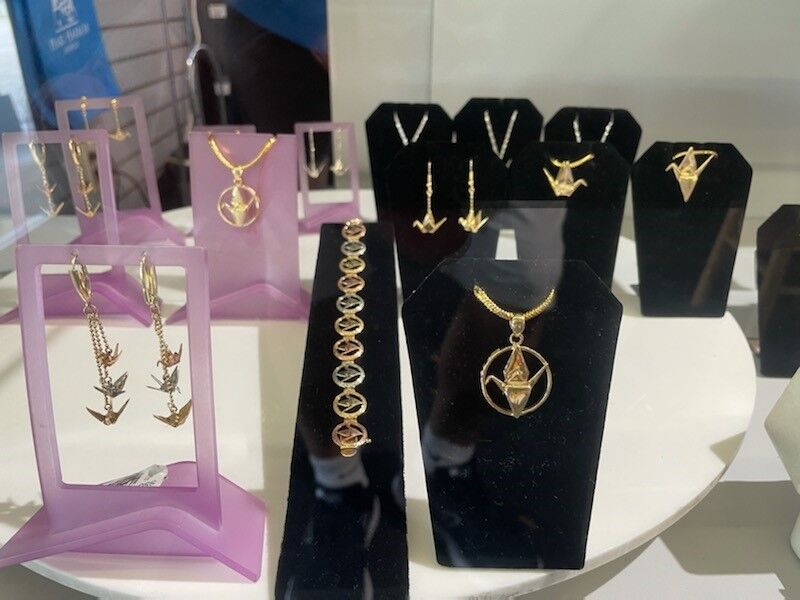
The Sadako Sasaki Peace Crane Collection on display at the Pearl Harbor Museum Store is an exclusive jewelry collection commissioned by Pacific Historic Parks. This collection can only be found at Pearl Harbor.



